
Hakata Port Tower is a 103 metre high lattice tower with an observation deck in a height of 73.5 metres in Hakata-ku, Fukuoka, Japan. Hakata Port Tower was built in 1964.

Hakata Port Tower is a 103 metre high lattice tower with an observation deck in a height of 73.5 metres in Hakata-ku, Fukuoka, Japan. Hakata Port Tower was built in 1964.

Fukuoka is the sixth-largest city in Japan, the second-largest port city after Yokohama, and the capital city of Fukuoka Prefecture, Japan. The city is built along the shores of Hakata Bay, and has been a center of international commerce since ancient times. The area has long been considered the gateway to the country, as it is the nearest point among Japan's main islands to the Asian mainland. Although humans occupied the area since the Jomon period, some of the earliest settlers of the Yayoi period arrived in the Fukuoka area. The city rose to prominence during the Yamato period. Because of the cross-cultural exposure, and the relatively great distance from the social and political centers of Kyoto, Osaka, and later, Edo (Tokyo), Fukuoka gained a distinctive local culture and dialect that has persisted to the present.

Hakata Station is a major railway station in Hakata-ku, Fukuoka, Japan. It is the largest and busiest railway terminal in Kyushu, and is a gateway to other cities in Kyushu for travelers coming from Honshu by rail travel. The San'yō Shinkansen from Osaka ends at this station.

The Fukuoka earthquake struck Fukuoka Prefecture, Japan at 10:53 am JST on March 20, 2005, and lasted for approximately 1 minute. The Japan Meteorological Agency (JMA) measured it as peaking at a magnitude of 7.0, whereas the United States Geological Survey (USGS) reported a magnitude of 6.6. The quake occurred along a previously unknown fault in the Genkai Sea, North of Fukuoka city, and the residents of Genkai Island were forced to evacuate as houses collapsed and landslides occurred in places. Investigations subsequent to the earthquake determined that the new fault was most likely an extension of the known Kego fault that runs through the centre of the city.
Nakasu (中洲) is the red-light district which exists between the sandbank of the Naka River and the Hakata River in Fukuoka City, Fukuoka Prefecture, Japan. It is named after a popular, but very short-lived, entertainment quarter of Edo, which existed in the late 18th century. The name "Nakasu" can be translated as "the island in the middle", as Nakasu is an island between two rivers.

Sawara-ku (早良区) is one of the wards in Fukuoka-shi, Fukuoka-ken, Kyūshū, Japan.
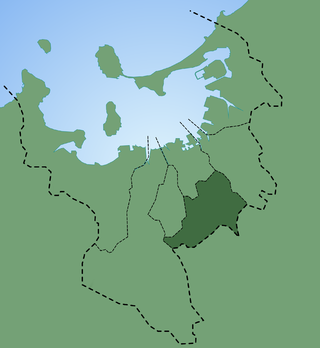
Minami-ku (南区) is one of the seven wards of Fukuoka City, Japan. As of 2004, it had a population of 247,913 people and an area of 30.98 km2. As of 2016, the population had increased to 255,000 people with 8,200 per km2. Its name literally means "south ward." It is bordered by the central, Hakata, Jonan, and Sawara wards of Fukuoka city, and also by the cities of Nakagawa and Kasuga. Sasabaru Station within the ward is on the JR Kagoshima main line. It also has three stations on the Tenjin Ōmuta Line.

Fukuoka Tower is a 234-metre (768 ft) tall tower located in the Momochihama area of Fukuoka, Japan. It is the tallest seaside tower in Japan. The highest observation deck at 123 metres has a 360° view of the surrounding area, being most visited at sunset. Fukuoka Tower was finished in 1989, taking a total of 14 months to build at a cost of ¥6 billion. It was designed by Nikken Sekkei and constructed on a reclaimed land out of Hakata Bay.
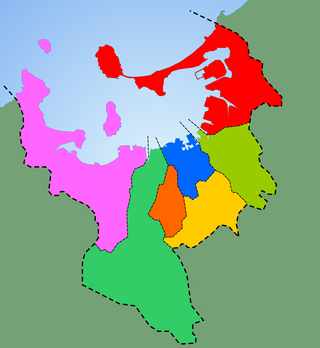
Hakata Bay is a bay in the northwestern part of Fukuoka city, on the Japanese island of Kyūshū. It faces the Tsushima Strait, and features beaches and a port, though parts of the bay have been reclaimed in the expansion of the city of Fukuoka. The bay is perhaps most famous for the Mongol invasions of Japan of 1274 and 1281 which took place nearby; both invasions are sometimes referred to as the "Battle of Hakata Bay."

Maidashi-Kyūdaibyōinmae Station is a subway station on the Fukuoka City Subway Hakozaki Line in Fukuoka, Japan.
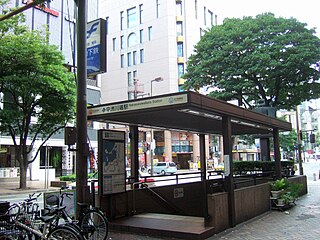
Nakasu-Kawabata Station is a subway station on the Hakozaki Line and Kūkō Line located in Hakata-ku, Fukuoka in Japan. The station's symbole mark is Chinese characters "中" and "川" look like Happi's motif.

Tenjin-Minami Station is a subway station located in Chūō-ku, Fukuoka. It is connected to Tenjin Station and Nishitetsu Fukuoka (Tenjin) Station through the Tenjin Chikagai, an underground shopping street. The station symbol is children playing the "Tōryanse" game.
Fukuoka Prefectural Fukuoka High School is a co-educational public senior high school located in Hakata ward, Fukuoka city, Fukuoka prefecture, Japan. It is often called "Fukkō" (福高) for short. Note, however, that there are several high schools with similar names in Saitama Prefecture in Eastern Japan and Iwate Prefecture in Northern Japan, Toyama Prefecture in central Japan.
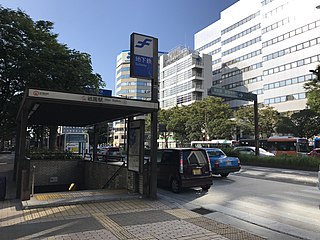
Gion Station is a train station located in Hakata-ku, Fukuoka in Japan. Its station symbol is a young male dressed in happi, representing the famous Hakata Gion Yamakasa, held in July each year.

Higashi-Hie Station is a train station located in Hakata-ku, Fukuoka in Japan. The station's symbol mark is Hie's initials "ひ" looks like earthenware, because Hie remains, and "ひ"'s each edges circle mean Hakata and Airport.

Sakurazuka Station (桜坂駅) is a subway station on the Fukuoka City Subway Nanakuma Line in Chūō-ku, Fukuoka in Japan. Sakurazuka is literally "cherry blossom slope" in Japanese. So its station symbol is a picture of seven cherry blossom petals in pink is fluttering in the wind.

Canal City Hakata (キャナルシティ博多) is a large shopping and entertainment complex in Fukuoka, Japan. Called the "city within the city," it boasts numerous attractions including shops; cafes; restaurants; a theater; game center; cinemas; two hotels; and a canal, which runs through the complex.

Jōten-ji (承天寺) is a Rinzai temple in Hakata, Fukuoka, Japan. Its honorary sangō prefix is Banshōsan (萬松山). It was founded by Enni-Ben'en with support from Xie Guo Ming, a Chinese merchant, and construction was completed in 1242.

Island City (アイランドシティ) is artificial island in Hakata Bay, Fukuoka, Japan. Island Tower Sky Club and Teriha Sekisui House Arena are on this island.
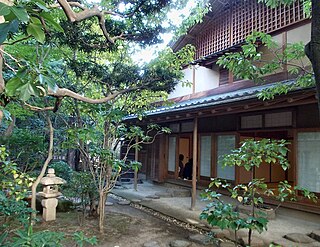
Rakusui-en (楽水園) is a garden in Hakata-ku, Fukuoka, Japan. It was originally built in 1906 for Shimozawa Zenemon Chikamasa, a Hakata merchant. In 1995, Fukuoka City overhauled the structure and reopened it as a Japanese garden where visitors can experience a tea ceremony; with four tea rooms it is often used for tea ceremonies and related training.

Fukuoka Sunpalace is a hotel and concert hall complex in Hakata-ku, Fukuoka, Japan. The hall has a seating capacity of 2,316, and has hosted international bands and performers such as A-ha, Gloria Estefan and Miami Sound Machine, Roxette, Rainbow, Bon Jovi, Ringo Starr, Rush, and Phil Collins.